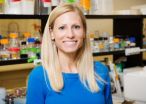(Press-News.org) RUSTON, La. – Dr. Mark DeCoster, the James E. Wyche III Endowed Professor in Biomedical Engineering at Louisiana Tech University, will present as an invited speaker at the International Bioprinting Congress, July 24-25 at the Biopolis Research and Development Center in Singapore.
DeCoster, who is also a research faculty member in Louisiana Tech's Institute for Micromanufacturing, will present a lecture titled, "Bioprinting interfaces for 2D and 3D cell and tissue models." The presentation will focus on the development of a novel, matrix-free method for generating 3D cell spheroids that are combining knowledge from bioprinting methods on 2D surfaces to link 3D cellular structures.
"The cells of our bodies exist in both a three dimensional (3D) environment, which is rounder, as well as places that are more two dimensional (2D) or flattened," said DeCoster. "What is so new and exciting about 3D printers in the biomedical sciences and engineering is that we can now enable our imagination to convert a good idea into something that is printable and testable in 3D, and could have significant impacts on human health.
"3D printers are now replicating materials that are compatible with biology and medicine such as delivery of drugs to fight off cancer or growth-promoting materials that can be used for tissue engineering to heal a wound or repair a damaged part of the body."
In his laboratory, DeCoster says he and his team are using 3D printers and other materials to generate cell-friendly building blocks to control and study cells as groups both in 3-dimensions and in 2-dimensions.
"We feel this is important because we need to understand how to put cells together to grow better tissues or repair them, and also to understand how damaged or diseased cells behave," DeCoster said.
DeCoster received his Ph.D. in biochemistry and molecular biophysics from the Medical College of Virginia at Virginia Commonwealth University, and his bachelor's degree in biology from the College of William and Mary. His research interests include combining nanotechnology with cell biology to understand systems in the brain and in disease states such as cancer. DeCoster has published 60 peer-reviewed papers with over 1,750 citations of this work, and has served extensively as a reviewer for the National Institutes of Health (NIH) and for more than 25 different scientific journals.
The International Bioprinting Congress features leading international scientists and thought leaders, and provides the attendees with detailed insights into the latest developments and techniques in 3D bioprinting. Attendees also learn about the many advances in 3D bioprinting including additive manufacturing of tissues and biofabrication, scaffolds and biomaterials for tissue engineering, biological laser printing, biological inkjet printing, and the search for the synergy by fusion of bio-additive manufacturing and micro manufacturing.
"We need to understand both the 2D and 3D environments since different parts of the body use different materials to function, and this complexity of materials will most likely also be needed in bioprinting," explains DeCoster. "In my presentation at the International Bioprinting Congress, I look forward to sharing the research we're doing at Louisiana Tech on how normal cells of the brain as well as cancer cells (such as in brain tumors), can be studied using materials from 3D printers and how we combine those materials with cells."
INFORMATION: END
Louisiana Tech University professor presents at International Bioprinting Congress
2014-07-21
ELSE PRESS RELEASES FROM THIS DATE:
UCI researchers find epigenetic tie to neuropsychiatric disorders
2014-07-21
Irvine, Calif., July 21, 2014 — Dysfunction in dopamine signaling profoundly changes the activity level of about 2,000 genes in the brain's prefrontal cortex and may be an underlying cause of certain complex neuropsychiatric disorders, such as schizophrenia, according to UC Irvine scientists.
This epigenetic alteration of gene activity in brain cells that receive this neurotransmitter showed for the first time that dopamine deficiencies can affect a variety of behavioral and physiological functions regulated in the prefrontal cortex.
The study, led by Emiliana Borrelli, ...
Transiting exoplanet with longest known year
2014-07-21
Astronomers have discovered a transiting exoplanet with the longest known year. Kepler-421b circles its star once every 704 days. In comparison, Mars orbits our Sun once every 780 days. Most of the 1,800-plus exoplanets discovered to date are much closer to their stars and have much shorter orbital periods.
"Finding Kepler-421b was a stroke of luck," says lead author David Kipping of the Harvard-Smithsonian Center for Astrophysics (CfA). "The farther a planet is from its star, the less likely it is to transit the star from Earth's point of view. It has to line up just ...
Communication about female condom vital to young adults, UT Arlington researchers say
2014-07-21
The female condom is one of just two barrier methods that can protect against sexually transmitted infections and unplanned pregnancies, yet many young adults are not aware of the device, a new study by two UT Arlington researchers has found.
They say the reason could lie in the way information about the female condom is communicated to young people.
Charla Markham Shaw, associate professor of communication, and Karishma Chatterjee, an assistant professor of communication studies in The University of Texas at Arlington College of Liberal Arts, co-authored the paper "Communicating ...
Parents rank their obese children as 'very healthy'
2014-07-21
A University of California, San Diego School of Medicine-led study suggests that parents of obese children often do not recognize the potentially serious health consequences of childhood weight gain or the importance of daily physical activity in helping their child reach a healthy weight.
The study is published online in the Journal of the Academy of Nutrition and Dietetics.
"Parents have a hard time changing their child's dietary and physical activity behaviors," said lead author Kyung Rhee, MD, and an assistant adjunct professor in the Department of Pediatrics. "Our ...
NASA satellite sees Typhoon Matmo brush eastern Philippines
2014-07-21
A NASA satellite captured an image of the western quadrant of Typhoon Matmo brushing over the eastern Philippines on July 20.
NASA's Terra satellite passed over Typhoon Matmo on July 20 at 02:15 UTC and the Moderate Resolution Imaging Spectroradiometer or MODIS instrument aboard captured a visible image of the storm. The MODIS image showed a thick band of thunderstorms west of the storm's center were sweeping over the eastern Philippines.
The Joint Typhoon Warning Center (JTWC) noted that animated multispectral satellite imagery on July 21 showed that convection (rising ...
Stem cells aid muscle repair and strengthening after resistance exercise
2014-07-21
CHAMPAIGN, Ill. — A new study in mice reveals that mesenchymal (mezz-EN-chem-uhl) stem cells (MSCs) help rejuvenate skeletal muscle after resistance exercise.
By injecting MSCs into mouse leg muscles prior to several bouts of eccentric exercise (similar to the lengthening contractions performed during resistance training in humans that result in mild muscle damage), researchers were able to increase the rate of repair and enhance the growth and strength of those muscles in the exercising mice.
The findings, described in the journal Medicine and Science in Sports and ...
Climate: Meat turns up the heat
2014-07-21
Stanford, CA—Eating meat contributes to climate change, due to greenhouse gasses emitted by livestock. New research finds that livestock emissions are on the rise and that beef cattle are responsible for far more greenhouse gas emissions than other types of animals. It is published by Climactic Change.
Carbon dioxide is the most-prevalent gas when it comes to climate change. It is released by vehicles, industry, and forest removal and comprises the greatest portion of greenhouse gas totals. But methane and nitrous oxide are also greenhouse gasses and account for approximately ...
Can amyloid plaque in Alzheimer's disease affect remote regions of the brain?
2014-07-21
New Rochelle, NY, July 21, 2014—In Alzheimer's disease, accumulation of amyloid plaque in the brain is believed to play an important role in many characteristic disease symptoms, including memory loss and other mental state changes. But how these plaque deposits affect brain function is not well understood. Important new study results showing that plaque buildup in one area of the brain can negatively affect metabolism in a more distant brain region have been published in Brain Connectivity, a peer-reviewed journal from Mary Ann Liebert, Inc., publishers. The article is ...
Increased overall survival for advanced stage non-small cell lung cancer patients is associated with availability of less toxic chemotherapy
2014-07-21
DENVER – A 10-year population-based study shows that increased availability of better systemic chemo- and targeted-therapies for patients with advanced non-small cell lung cancer (NSCLC) coincides with increased usage of these therapies. This in turn leads to a significant increase in overall survival.
Researchers from the British Columbia Cancer Agency, Vancouver, Canada, performed a retrospective chart review of all patients referred to the agency with advanced stage (IIIB or IV) lung cancer and grouped the patients into 4 one-year time frame cohorts; one termed "baseline" ...
ROS1 gene fusions are found in 2.4 percent of Asian patients with lung adenocarcinoma
2014-07-21
DENVER -- ROS1 fusion genes were successfully detected independent of gender or smoking history in young East Asian patients with lung adenocarcinoma, a histological subgroup in non-small cell lung cancer (NSCLC), using multiplex reverse transcriptase-polymerase chain reaction (RT-PCR) and immunohistochemistry (IHC) diagnostic tests.
In NSCLC treatment algorithms, a personalized therapy approach is now being taken based on the genetic characteristics of the cancer. Patients with specific oncogenic molecular aberrations, for example EGFR mutations and ALK gene fusions, ...





